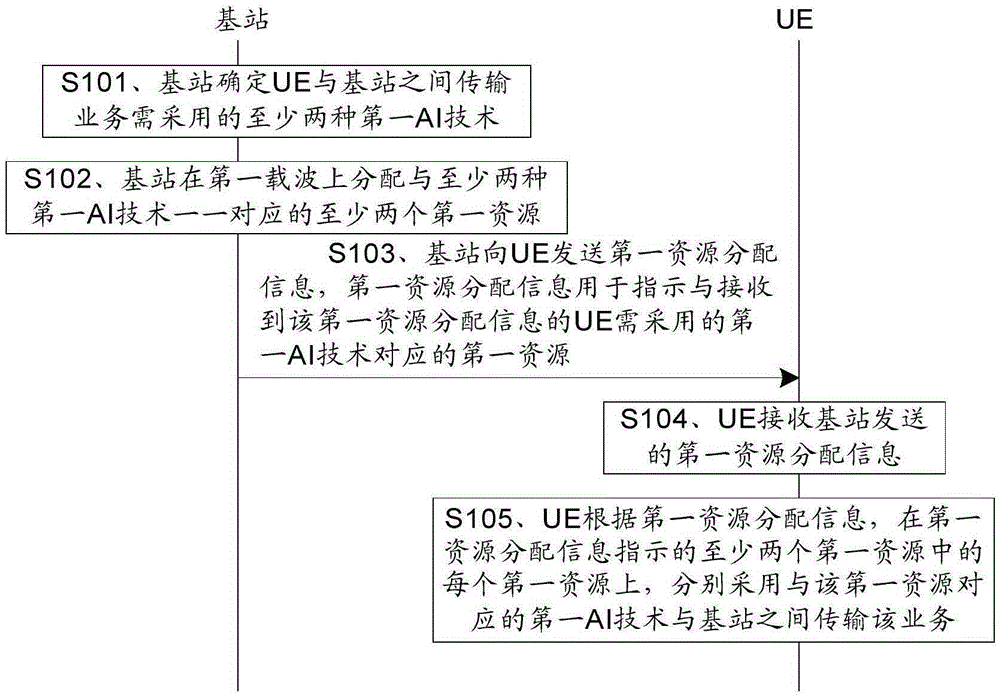Resource allocation method and device, and wireless access system
A technology for resource allocation and wireless access equipment, which is applied in the field of wireless access systems and resource allocation, and can solve problems such as low resource utilization and inflexible resource utilization
- Summary
- Abstract
- Description
- Claims
- Application Information
AI Technical Summary
Problems solved by technology
Method used
Image
Examples
Embodiment 1
[0181] like figure 1 As shown, the embodiment of the present invention provides a resource allocation method, and the resource allocation method may include:
[0182] S101. The base station determines at least two first AI technologies to be used for service transmission between the UE and the base station.
[0183] In the embodiment of the present invention, when transmitting services between the UE and the base station (including sending data from the base station to the UE and sending data from the UE to the base station, the service / data includes signaling and user data), the first AI technology needs to be used. Wherein, the first AI technology is also called radio interface technology (English: radio interface technology, abbreviated: RIT) or radio interface protocol (English: radio interface protocol, abbreviated: RIP). The first AI technology may generally include multiple access (English: multiple access), modulation and coding scheme (English: modulation and coding ...
Embodiment 2
[0388] like Figure 20 As shown, the embodiment of the present invention provides a resource allocation method, and the resource allocation method may include:
[0389] S201. The base station determines at least two first AI technologies to be used for service transmission between the UE and the base station.
[0390] S202. The base station allocates at least two first resources corresponding to at least two first AI technologies on the first carrier.
[0391] Wherein, at least two first resources are used for transmitting services between the UE and the base station.
[0392] S203. The base station sends first resource allocation information to the UE, where the first resource allocation information is used to indicate a first resource corresponding to a first AI technology to be adopted by the UE that receives the first resource allocation information.
[0393] In this embodiment, the number of the foregoing UEs may be one or multiple. When the number of the above-mention...
Embodiment 3
[0401] like Figure 21 As shown, the embodiment of the present invention provides a resource allocation method, and the resource allocation method may include:
[0402] S301. The UE receives first resource allocation information sent by the base station.
[0403] Wherein, the first resource allocation information is used to indicate at least two first resources allocated by the base station on the first carrier, the at least two first resources are used for transmitting services between the UE and the base station, and the transmission of the services between the UE and the base station requires At least two first AI technologies are used, and the at least two first AI technologies correspond to at least two first resources one-to-one.
[0404]S302. According to the first resource allocation information, on each of the at least two first resources indicated by the first resource allocation information, the UE respectively adopts the first AI technology corresponding to the fi...
PUM
 Login to View More
Login to View More Abstract
Description
Claims
Application Information
 Login to View More
Login to View More - R&D
- Intellectual Property
- Life Sciences
- Materials
- Tech Scout
- Unparalleled Data Quality
- Higher Quality Content
- 60% Fewer Hallucinations
Browse by: Latest US Patents, China's latest patents, Technical Efficacy Thesaurus, Application Domain, Technology Topic, Popular Technical Reports.
© 2025 PatSnap. All rights reserved.Legal|Privacy policy|Modern Slavery Act Transparency Statement|Sitemap|About US| Contact US: help@patsnap.com



